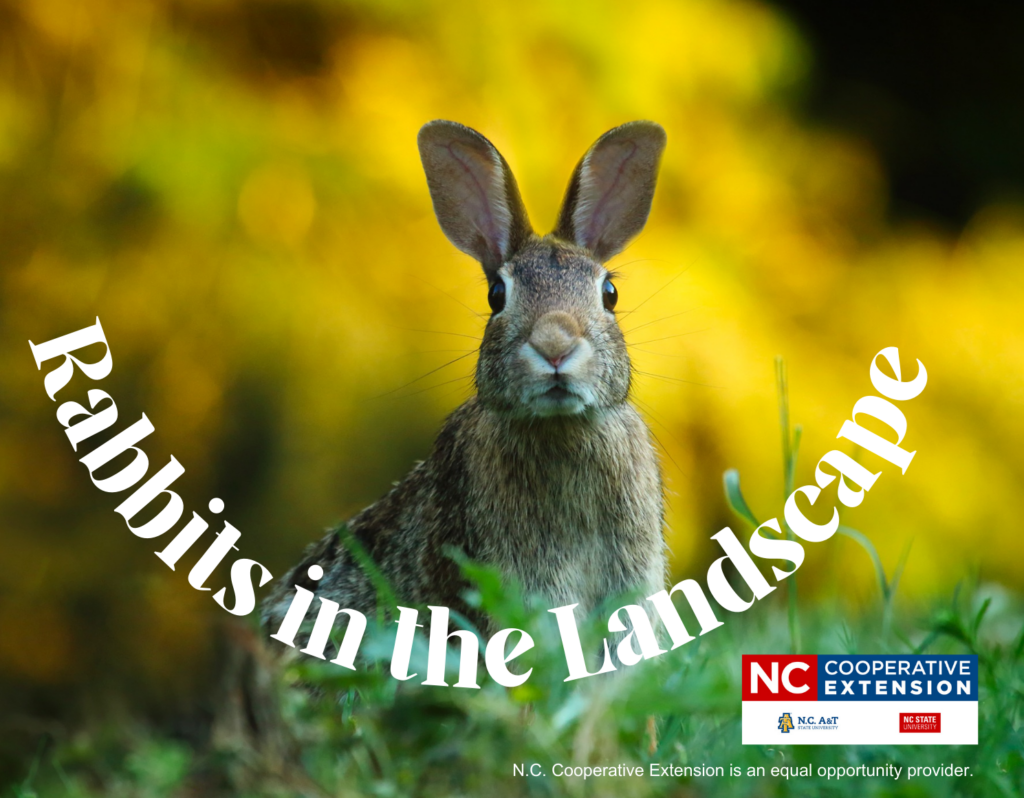Rabbits in the Landscape
go.ncsu.edu/readext?995308
en Español / em Português
El inglés es el idioma de control de esta página. En la medida en que haya algún conflicto entre la traducción al inglés y la traducción, el inglés prevalece.
Al hacer clic en el enlace de traducción se activa un servicio de traducción gratuito para convertir la página al español. Al igual que con cualquier traducción por Internet, la conversión no es sensible al contexto y puede que no traduzca el texto en su significado original. NC State Extension no garantiza la exactitud del texto traducido. Por favor, tenga en cuenta que algunas aplicaciones y/o servicios pueden no funcionar como se espera cuando se traducen.
Português
Inglês é o idioma de controle desta página. Na medida que haja algum conflito entre o texto original em Inglês e a tradução, o Inglês prevalece.
Ao clicar no link de tradução, um serviço gratuito de tradução será ativado para converter a página para o Português. Como em qualquer tradução pela internet, a conversão não é sensivel ao contexto e pode não ocorrer a tradução para o significado orginal. O serviço de Extensão da Carolina do Norte (NC State Extension) não garante a exatidão do texto traduzido. Por favor, observe que algumas funções ou serviços podem não funcionar como esperado após a tradução.
English
English is the controlling language of this page. To the extent there is any conflict between the English text and the translation, English controls.
Clicking on the translation link activates a free translation service to convert the page to Spanish. As with any Internet translation, the conversion is not context-sensitive and may not translate the text to its original meaning. NC State Extension does not guarantee the accuracy of the translated text. Please note that some applications and/or services may not function as expected when translated.
Collapse ▲Though Easter is a time often adorned with bunnies delivering colorful eggs to your garden, more often those little guys are a gardener’s enemy. Rabbits can cause a wide range of damage to plants in the landscape. These garden pests do, however, offer a great source of fertilizer through their feces. More often though they cause more harm than good in the garden.
There is rarely a full proof way to eradicate these pests from our gardens. Often, we must learn to coexist with them. This means that identifying when too much damage has taken place is critical. We can expect some damage to plants each year. This can look like a light frost in spring or rabbit/deer decimating an entire bed. Knowing when a plant can recover and when they can’t plays a huge role in the steps we should take to remove or deter these pests. Often a plant can withstand 1/3 of it being removed. Early in spring this can even be higher. If you see damage instead of waging war perhaps you simply place a barrier around the plant and allow it to grow out of it. There are several options you can take to deter rabbits from entering your garden. Rest assured that the Easter bunny is immune to these deterrents!
One thing that should NOT be done is relocation! In the state of North Carolina relocating any wild animal is illegal. Keep in mind often if you do move an animal another will simply move back in in its place. Putting other measures in place would lead you to much more success and keep you out of trouble.
One option is to grow plants that rabbits don’t like the taste of. These plants can however, be hard to find. Also, if the rabbits are hungry enough, they will likely decide that the plant is worth a nibble or two. Very few to no plants are fully resistant to rabbit or deer. If they become hungry enough anything is fair game. Often, these situations take place in late winter when resources are running very low.
Sprays formulated to smell like predators’ urine is a common option. These are liquid sprays that you spray around the edge of your landscapes. The smell will deter small mammals from entering the area. Making them think a predator is nearby. These sprays need to be replied often to be useful. In the event of rain all the spray will be removed from the plant and need to be reapplied. These sprays should be seen as a short-term fix knowing they should be reapplied often.
Continuing on the idea of predators, often dogs and cats are great deterrents. Once the rabbits know they are around they will remain skeptical of the area. Most often just the scent of a dog is enough to persuade a rabbit to move along. This is also true for most all prey type animals that like our landscapes.
A fence is another great option however, rabbits can dig. Burying the fence may be necessary to fully exclude them. This will also be helpful in preventing large mammal pest as well. Such as deer that are becoming ever more present in our landscapes. Exclusion is one of the best options, if the animals simply can’t enter no damage can be done.
Discouraging habitat and hiding places also helps greatly. Keeping grass cut to a short length helps minimize their natural cover. Rabbits often hide on tall grass this is also where they raise their young. Large brush piles and areas with tall weeds should also be minimized. See this article from Washington State for more information on ideal habitat for rabbits and what to ovoid.
Though rabbits are a nuisance they are a native part of our ecosystem. Meaning that completely eradicating them would likely lead to greater issues than a dead Hosta. There is however, a middle ground where we can co-exist with these mammals. Allowing them to have their natural areas while we have our landscapes. Adjusting our tolerance levels to some damage may be one of the first steps.





